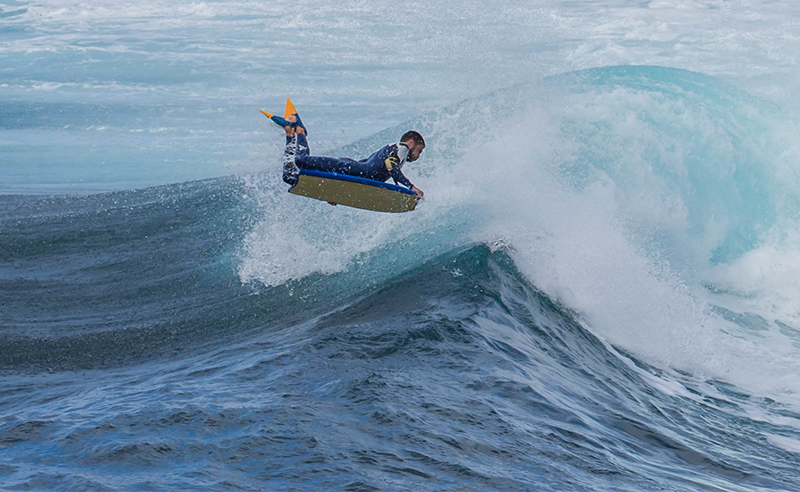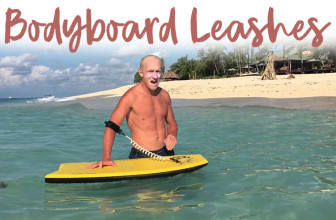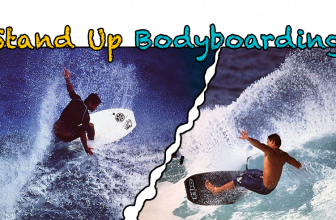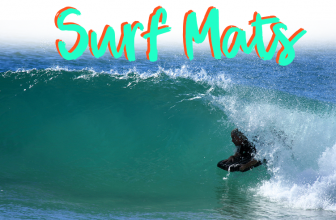
Bodyboarding: The underdog watersport that has been conquering the world since its inception almost 50 years ago.
While we can trace bodyboarding all the way back to the indigenous Polynesians who rode wooden Alaia boards, it wasn’t until 1971 that we were faced with the modern bodyboard design that we know and love today.
This is all thanks to the bodyboard, or boogieboard, inventor: Tom Morey. On July 9, 1971, Tom Morey woke up with the feeling to create something brand new.
He shaped a small plank that was just 23” wide and 4’6” long.
It only weighed 3 pounds. Of course since he was living on the Big Island, he needed to test it out.
He paddled his way out into Honels, a popular spot on the Western side of the island, and rode the board around in the knee-high surf.
There was no doubt in his mind that he had made something big.
Less than a year later, Morey decided to sign a deal with G&S Surfboards to manufacture and distribute boards.
The brand name: Morey Boogie.
He was absolutely the pioneer of the new sport and sold thousands of boards to people around the world who were eager to be a part of the new movement.
Rubber Mats
Now before we get deeper into bodyboarding history, you must know where the inspiration came from.
Ever heard of surf mats? These things go all the way back to the 1930s when Ernest Smithers, a physician from Bronte, Australia, invented the world’s first surf mat, the Surf-O-Plane”. It was a four-ribbed rubber mat with one inflation valve and two grip handles up front. It was just under 3-feet in length and was easily the most popular beach item in Australia at the time.
By the 1960s, these mats were EVERYWHERE. They were the classic inflatable surf vehicles and were the predecessors of bodyboards. Interested in riding one? You’ll be happy to know that many manufacturers are continuing to build classic models to this day. Now back to the boogie!
Bodyboarding Pioneers
Bodyboarding would be nothing without the fearless shredders who took it from a play-thing to a serious shred stick. Let’s take a look at some of the most popular pioneers in bodyboarding history:
Phyllis Dameron
Phyllis Dameron was the first woman to ride Waimea Bay on a bodyboard in the late 1970s. At this time, this Oahu beach was known for its massive overheads that even some surfers weren’t brave enough to conquer. What makes Phyllis Dameron so freaking cool is that she was never sponsored, she never entered contests, and her riding was unlike anything else. As a bodyboarder, she was free, and yet, one of the best in history.
Pat Caldwell
No watersport is complete without classic tricks and maneuvers, and Pat Caldwell invented one of the most popular ones: The El Rollo. At 16-years old, Pat hit The Pipeline to show off his lip-hitting, rotating maneuver, with no idea that it would become one of the most fundamental tricks in modern bodyboarding.
Mike Stewart
Nine-time world champion bodyboard Mike Stewart, is easily one of the most experienced bodyboarders alive, and has been riding pipelines since the early 1980s. He won the very first Morey Boogie Bodyboarding Pro Championship at the Pipeline in 1982, won his first on nine world titles in 1983, and invented the Gyroll maneuver, one of bodyboarding’s most popular maneuvers next to the El Rollo.
Morey and the Mach 7
Because bodyboarding was becoming such a popular sport, it was necessary for Morey to create a versatile board that could be ridding by anyone. Therein came the Mach 7-7, a board that still stands today as one of the most iconic and recognizable bodyboards in the world.
The original Mach 7-7 went through a few changes from its inception in 1981. The first generation was revolutionary in that it featured a slick bottom that provided less drag, meaning you could really start to barrel down the line. In 1983, Morey updated the board, added a crescent tail for versatility, and designed a classic orange-stripe bottom to give the board a more aesthetic appeal. The Third generation came around in 1989 and featured similar rails, an orange bottom, and a sweet little logo.
From there on, Morey introduced new generations like the Mach 7 SS and the Mach 7 X, both of which are still being manufactured and updated today.
Other Pioneering Companies
BZ
Bobby Szabad, one of Morey’s first apprentices, was a pioneer rider for Morey bodyboarding team. He worked from the bottom with Morey and was the head of production in many of his factories. He eventually left in the 80s to start BZ, a now-household name in bodyboarding. The boards, more than any other, were meant for high-performance riders who wanted to get out in more serious conditions.
Wham-O
After Tom Morey sold Morey Boogie to Kransco in1977, Kransco sold it to Wham-O in 1994. While they may not be the true creators of the bodyboards, they took the once unknown product and pushed it to a consumer market. If you were a kid in the 90s, there’s no doubt you knew about Wham-O. From Slip-N’-Slides to Hula Hoops to Frisbees and beyond, the company was and is still to this day, all about fun.
In the midst of bodyboards that are made for pros, Wham-O knew that they needed to market their less expensive boards to kids and families who just wanted some good, wholesome fun in the water, and that’s exactly what they did.
Science Bodyboards
In 1998, Mike Stewart launched his own bodyboarding company: Science Bodyboards. He took the wealth of knowledge and experience he had to manufacture some of the best bodyboards in the world. The most popular board was the “Zero Board”, a board that was a replica of the one he won his 11th pipe title on.
Hubboards
Hubboards was created by Jeff Hubbard, the 2012 IBA World Tour Bodyboarding champion. A year later, he created a modern-day pioneering company: Hubboards. These boards are no joke and are made for those who are involved in the serious sporting aspect of bodyboarding. Their quad-core board are highly-praised throughout the bodyboarding community for their speed, durability, and high-performance features. The guys at Hubboards are easily the next generation pioneers of the sport.
The Evolution
The first bodyboards were manufactured by Tom Morey in his own backyard. They were cut from polyethylene foam, glued together, and finished with tape. The first one even had newspaper all over it. Since then, bodyboards have gone through numerous evolutions in terms of designs and features.
Modern boards are now made with different types of foam cores including polyethylene, arcel, polypropylene, and have bottoms made of Surlyn or Bixby. They’re much stronger than traditional boards and have more flex, control, and speed. Unlike traditional boards, modern boards will typically have stringers made of wood, carbon, or graphite, to give the board stiffness. Needless to say, they’ve come quite a way
The World Tour
The APB World Tour, which started as the GOB World Tour in 1994 and changed to the IBA World Tour in 2003 before accepting its current name, was born out of the success of past world championships like the Morey Boogie Bodyboard Pro. It came around just after the era of Mike Stewart’s title domination, and paved way for bodyboarders around the world to compete.
The very first GOB World Tour was held in Brazil. The title was taken home by Guilherme Tamega and Claudia Ferrari. Since then, the World Tour’s have been held all around the world in countries such as South Africa, Australia, the US, and even France.
Drop Knee Bodyboarding
Drop Knee Bodyboarding, otherwise known as DKA, is a style of bodyboarding that takes a different approach. Instead of riding flat, bodyboarders began to ride on one knee. They style had been around since the inception of bodyboards, though companies didn’t really start manufacturing the proper gear for it until the mid-1980s.
DK riders have more of the weight on the back of the boards, meaning DK boards needed to wider tails and thinner noses. It was also important for these riders to build up speed before entering a wave, so it was necessary that they wear fins to get the best rides possible. DK bodyboarding allowed for the introduction of tricks that were once exclusive to surfing. If you ever want to take a break from riding prone, we recommend giving this style of riding a shot.
Frequently Asked Questions
Can you surf big waves with a bodyboard?
Absolutely, though you really need to be confident in your abilities, as not many mistakes are accepted in big wave riding. Just ask Mike Stewart and Ben Severson, who first took their bodyboards to Teahupoo in Tahiti (one of the world’s most notorious big waves) in 1986.
What is the craziest trick ever pulled in bodyboarding?
While it’s a subjective question, there is certainly one that comes to mind. In 2013, bobyboarder Jake Stone became the first person to ever pull of a 720 air on a bodyboard. This maneuver made history as it was completed during the New South Wales Coast Crusade. It has no doubt set a benchmark in the world of bodyboarding for newcomers to top.
Final Thoughts
Bodyboarding is certainly still the youngest of all of the watersports out there. There will be many generations before it catches up with surfing in terms of popularity and industrial growth. As a competitive sport, it is still very much on the underground.
Even with all that said, bodyboards are pretty much available everywhere and their availability and popularity will only continue to grow as time moves on.





